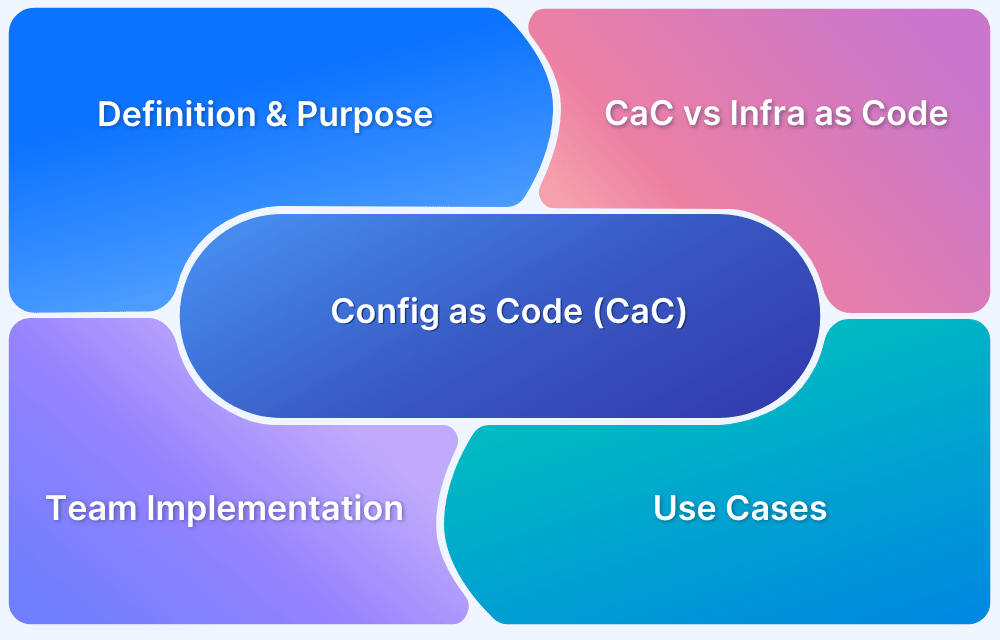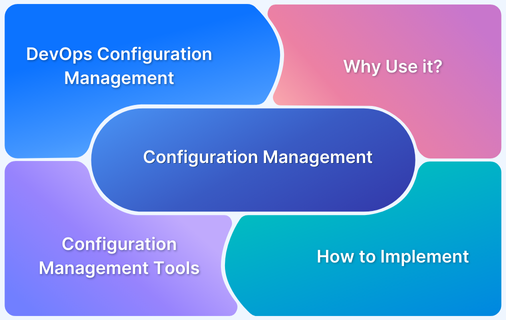Managing infrastructure and configuration manually can lead to inconsistencies, deployment delays, and errors, making it challenging to maintain efficiency at scale.
As software development advances, Configuration as Code (CaC) streamlines workflows by automating configuration management, ensuring consistency, and accelerating deployments. Treating configurations like code enables version control, process automation, and error reduction.
This article explores Configuration as Code, its benefits, best practices, and how it enhances modern development and deployment workflows.
What is Configuration as Code?
Configuration as Code is a method of managing software configurations by defining them in code and storing them in version control, just like application code.
This includes environment settings, resource provisioning, and deployment parameters, ensuring consistency and automation across development and production environments.
Unlike traditional methods where configurations are managed separately, Configuration as Code centralizes them within the codebase, making it easier to track, update, and synchronize changes across deployments.
Any modifications can be committed, reviewed, and deployed systematically, reducing manual effort and minimizing errors.
Read More: What is Configuration Testing
Core Principles of Configuration as Code
Here are the core principles of Configuration as Code:
1. Idempotency: Idempotency ensures that applying the same configuration multiple times results in a consistent outcome, preventing inconsistencies and configuration drift.
An idempotent script can be executed repeatedly without causing unintended side effects. This maintains system stability and predictability, ensuring that infrastructure remains in the desired state regardless of how many times the script runs.
2. Declarative Approach: A declarative approach specifies the desired system state rather than detailing step-by-step instructions. The system then determines the best way to reach that state.
This method simplifies configuration management, improves code readability, and reduces complexity, making it easier to maintain infrastructure.
3. Version Control: Storing configuration in a version control system allows teams to track changes, identify contributors, and roll back to previous states when necessary.
This fosters transparency, accountability, and consistency across deployments, ensuring that configurations are well-documented and controlled.
4. Continuous Validation: Automated validation helps detect configuration errors before deployment by continuously testing changes.
Integrating validation checks into the CI/CD pipeline allows teams to identify issues early, reducing downtime and maintaining system reliability.
Why use Configuration as Code?
Teams can benefit from implementing configuration as code in several ways.
Scalability
- Handling configuration changes as code, like IaC, enables teams to create, update, and maintain config files from a single centralized location while leveraging a consistent deployment approach.
- For instance, you require configuration files for each storage option if you are developing USB devices.
- You may create thousands of configurations by combining these files with the required software.
- To handle these variations, you need a robust, centralized source control that can be accessed from different levels in your CI/CD pipeline.
Standardization
- When the configuration is written like source code, you can use your development best practices, such as linting and security scanning.
- Before they are committed, config files must be reviewed and tested to guarantee that modifications adhere to your team’s standards.
- Your configurations can be maintained stable and consistent via a complicated microservices architecture.
- Services function more effectively together when a set process is in place.
Traceability
- Setting up configuration as code requires version control.
- You require a robust system that can conveniently save and track changes to your configuration and code files.
- This could improve the level of quality of your release.
- You can locate its source if a bug still slips through and rapidly identify/fix an issue by comparing the versioned configuration files.
Also Read: Why integrate with a Bug Tracking System?
Increased Productivity
- You may streamline your build cycle by turning configurations into managed code. Both IT and end users are more productive as a result.
- Your administrators may incorporate everything into a release or build from a single version control system.
- Developers are confident in the accuracy of their changes because every component of your workflow has been tested in concert.
When to Use Configuration as Code?
Configuration as code is used to manage settings for packages and components. This works across a wide range of industries. During the development of an app, configurations might be utilized to support several operating systems. By maintaining configuration as code, you may track hundreds or even thousands of hardware schematics and testing information for embedded development.
Learn More: What is DevOps Configuration Management?
How Teams implement Configuration as Code
You must decide how to save the configuration files you create or refactor in your code in your version control system.
Teams implement Configuration as Code in various ways:
- Put configuration files and code in the same repository (monorepo).
- Keep configuration files and code together based on your needs.
- component-based development and microservices.
- Keep configurations and code in separate repositories.
Below is a detailed description of each method to implement configuration as code.
Monorepo Strategy
Your workflow may be simpler if all your files are in one repository. However, if you treat configuration files as source code, any change to a setting can result in a fresh build. This might not be necessary and might make your team work more slowly.
Not every config update demands a build. Your system’s administrators would have to configure it to enable the merging of changes to configuration files. They might then be deployed to one of your pre-production environments to do further testing.
Because everything is code, it might be challenging to distinguish between configuration files and source code when performing an audit. Establishing a naming convention that is uniform across teams is crucial.
Microservices/Component Based Development
Teams often separate their code into several repos for various reasons. According to this architecture, configuration files are kept and versioned alongside the particular microservice or component.
Even though you might get a similar problem with trigger builds, it might be simpler to handle. Collaborate with your DevOps teams if you plan to version config files with their microservice or component. Plan how configuration changes will be distributed.
Must-Read: How to improve DevOps Feedback Loop
Separate Repos for Configuration Files
Whatever method you use to save your source code, some teams prefer to keep their configuration files in a separate repository. Although it sounds like an excellent idea, this is rarely viable.
Even the most complicated projects may contain fewer than a thousand configuration files. As a result, they would occupy a relatively small space within a repository. The setup of your build pipeline would require time from your administrators. You might wish to consider alternative solutions, even if this paradigm can be useful for audits, rollbacks, and reviews.
Infrastructure as Code vs Configuration as Code
Below are the key differences between Infrastructure as Code and Configuration as Code:
| Aspect | Infrastructure as Code (IaC) | Configuration as Code (CaC) |
|---|---|---|
| Definition | Treats infrastructure as software, allowing automated provisioning and management. | Manages application configuration settings as code to ensure consistency and automation. |
| Purpose | Automates infrastructure setup, including physical and virtual servers. | Automates software configuration updates without manual intervention. |
| Implementation | Uses scripts to define and create infrastructure before deployment. | Models application configurations and updates them dynamically. |
| Scope | Applies to servers, networks, and cloud infrastructure. | Applies to containers, microservices, and software applications. |
| Automation | Enables automated deployment and scaling of infrastructure. | Ensures seamless updates to application settings across environments. |
| GitOps Integration | Infrastructure updates are versioned and tested using CI/CD pipelines. | Configuration changes are pushed to version control and tested before deployment. |
| Key Benefit | Reduces manual effort in infrastructure provisioning and scaling. | Enhances consistency, eliminates configuration drift, and simplifies management. |
Also Read: What is Test Infrastructure?
Configuration as Code: Use Cases
Configuration as Code enables organizations to automate and standardize application configurations, ensuring consistency, reducing errors, and streamlining deployments.
Here are some practical applications of Configuration as Code:
- Version Control for Configuration: Managing configurations through version control ensures traceability, rollback capabilities, and collaboration. Storing configurations in repositories like Git allows teams to track changes, review updates, and maintain a single source of truth.
- Automated Build and Deployment Pipelines: Integrating Configuration as Code into CI/CD pipelines enables seamless configuration updates across environments. Automated deployment processes ensure that applications are configured correctly without manual intervention, reducing deployment risks.
- Configuration-Centric Test Environments: Instead of spinning up full-scale environments for minor configuration changes, teams can create lightweight test environments tailored to configuration updates. This improves efficiency and accelerates validation while minimizing infrastructure costs.
- Approval and Quality Control Processes: It supports structured review and approval workflows, ensuring that configuration changes go through necessary validations before deployment. This prevents misconfigurations and maintains stability across environments.
- Secure Secrets Management: Embedding secrets such as API keys, database credentials, and authentication tokens within configuration files poses security risks. Configuration as Code practices help integrate secure secrets management tools to safeguard sensitive information.
Enhancing Configuration Testing with BrowserStack
Ensuring that configuration changes work seamlessly across different browsers and devices is crucial for maintaining application performance.
With BrowserStack Live, teams can test configurations in real user conditions on a cloud-based infrastructure, eliminating the need for in-house device labs.
This allows for parallel testing, faster feedback loops, and greater confidence in configuration updates before deployment.
Best Practices of Implementing Configuration as Code
Here are some best practices that you should consider while implementing configuration as code:
- Use Version Control to track changes and enable rollbacks.
- Ensure Idempotency so repeated execution yields the same results.
- Adopt a Declarative Approach to define the desired state, not steps.
- Automate Testing and Validation to detect misconfigurations early.
- Implement Role-Based Access Control (RBAC) to restrict unauthorized changes.
- Encrypt Sensitive Data using vaults instead of storing secrets in configs.
- Ensure Cross-Environment Compatibility by testing on real devices with BrowserStack.
- Maintain Documentation and Standardization for consistency across teams.
Conclusion
Your development team can reap significant advantages by incorporating configuration as code into your process. Applying updates and ensuring that everything works as intended is made simpler by automating the deployment of configurations across environments. Changes are simple to manage and track because it uses a single repository.
While enhancing the development and deployment of code, configuration as code is a valuable tool for managing and controlling complex infrastructure and pipelines. As a result, you have the visibility and control you need to speed up development without compromising the security of your deployments.





